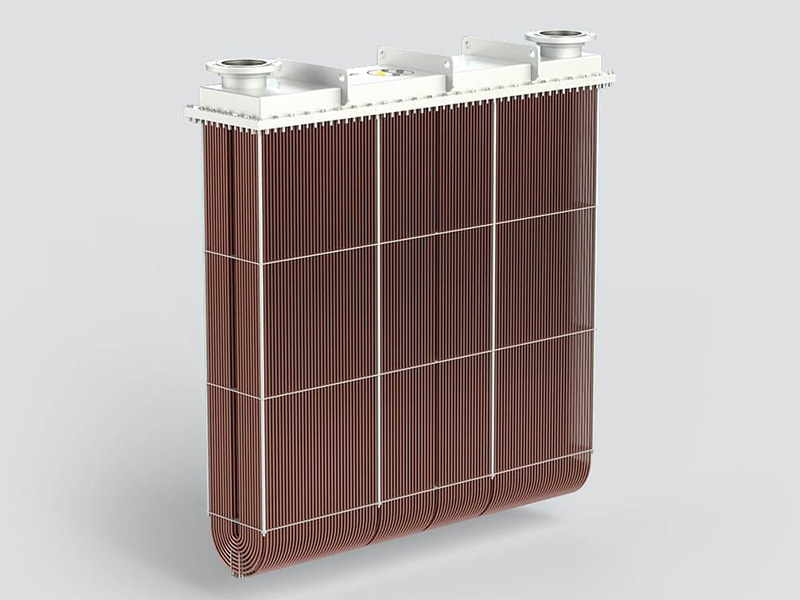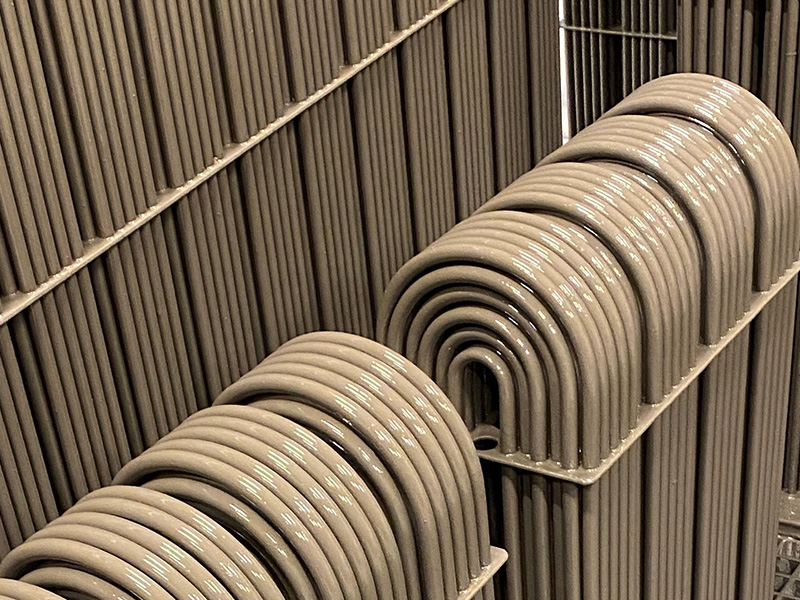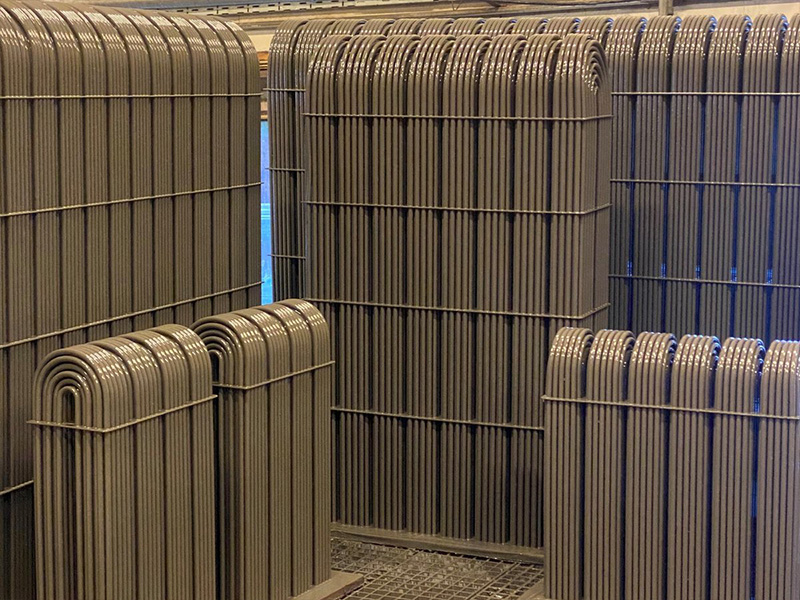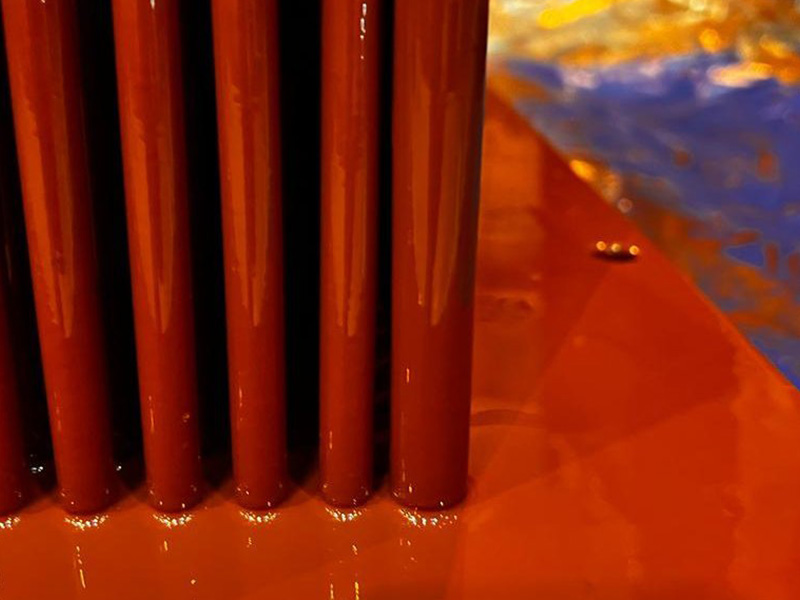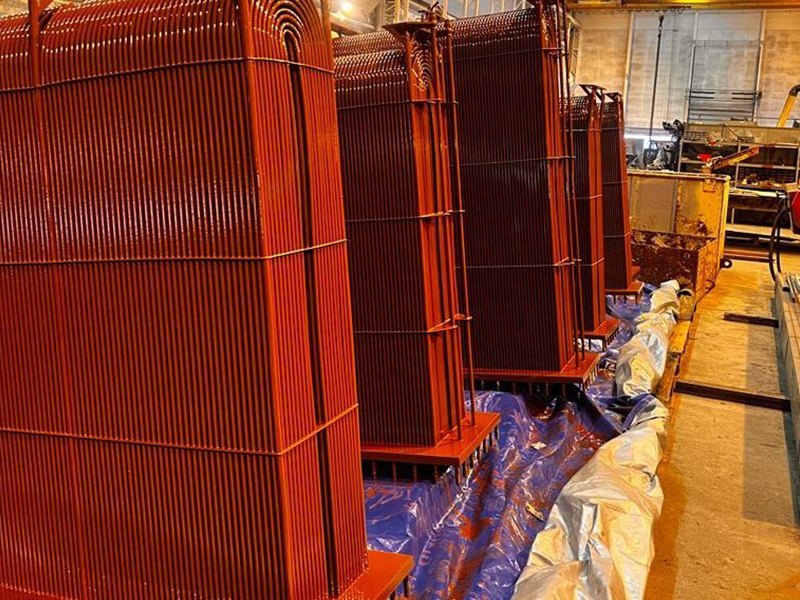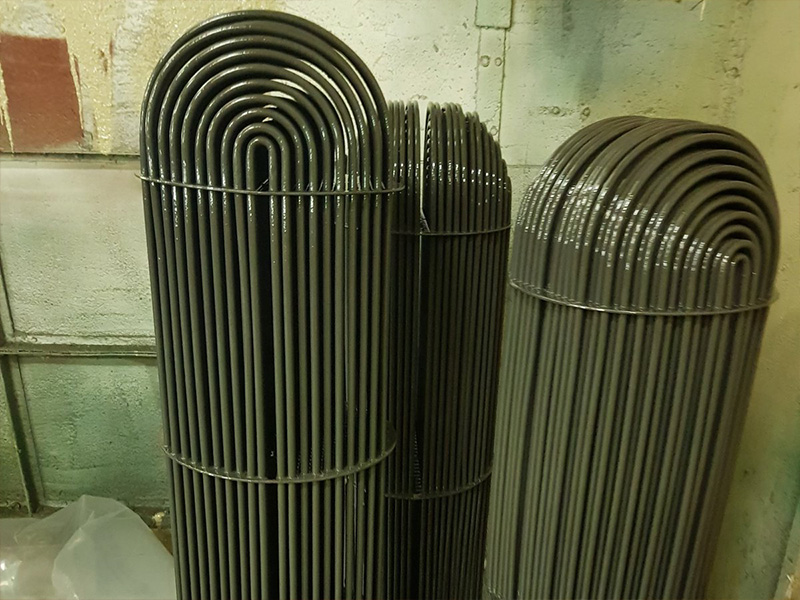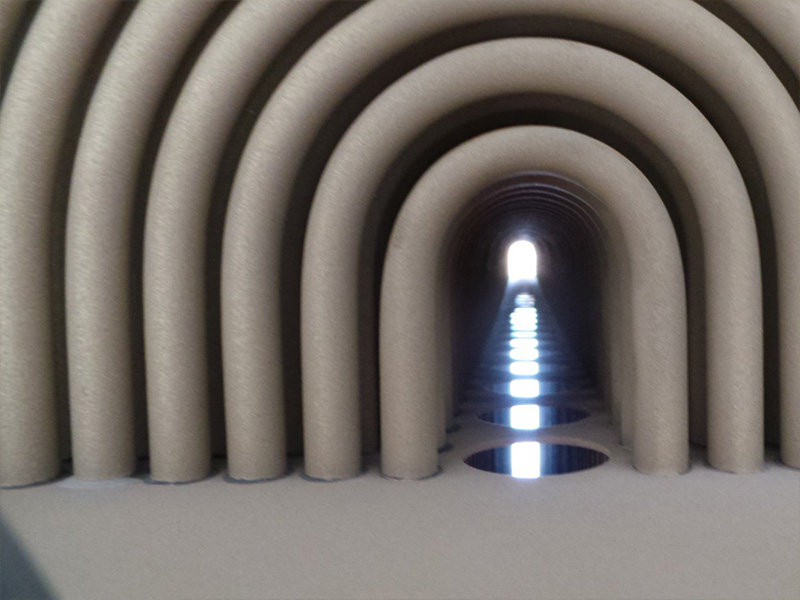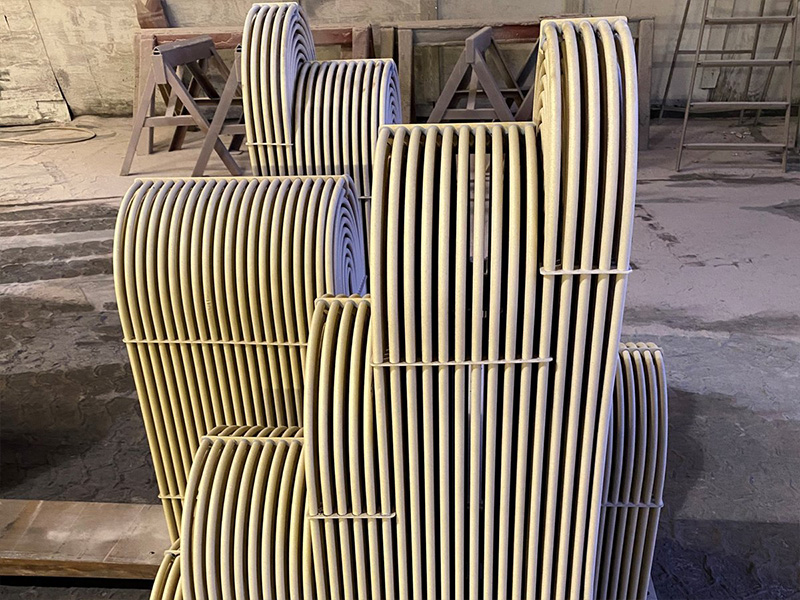SAEKAPHEN anti-corrosion coating for marine box coolers
Box Cooler, also known as Outboard Cooler, consists of multiple bundles of copper-nickel-aluminum (Cu-Ni-Al), etc. The cooler is directly installed in the seawater tank, which saves the cabin space and operation cost.
Box Cooler is generally used for cooling purpose of main engine, generator and auxiliary equipment etc. The applicable ship types include small and medium-sized cargo ships, oil tankers, tugs, barges, fishing vessels, ferries, supply vessels, refrigerated vessels, ice breakers etc.
Working Principle: The box cooler consists of water tank, spacer gasket, tube plate, mounting gasket, mounting flange and tube bundle. The integrated U-shaped tube bundle is expanded to the tube plate, and then the tube plate is bolted to the mounting flange on the top plate of the seawater tank.
The cooling effect of the box cooler is realized by forced circulation when the ship is sailing or natural convection when it is stationary. When the ship is sailing, the cooling seawater enters the seawater tank through the bottom grille, and then flows out along the outside of the U-shaped tube bundle through the top grille, and the cooling effect is realized through the forced circulation process of cooling seawater generated by the ship's sailing. When the ship is in dock or anchorage and other non-navigational state, the cooling seawater in the seawater tank and the ship cooling fresh water system for heat exchange, outboard seawater due to the temperature rise caused by the density of the outboard seawater becomes smaller so that the upward flow of the seawater tank, and at the same time, the bottom of the temperature of the sea water through the bottom of the lower temperature of the grille into the seawater tank, which formed the upward natural circulation process, and ultimately achieve the cooling effect (see Fig. 1).
Box cooler tube bundle unit all submerged in seawater work, although the tube bundle material has a strong resistance to seawater corrosion, but the cooler tube bundle external if not protected with a coating, the use of 6 months after the corrosion and rust, but also prone to biological fouling, such as shellfish, snails, seaweed and other sea creatures. When the box cooler on the beginning of attached organisms, it is difficult to observe the impact of the cooler on the thermal performance, only when the surface of the cooler is comprehensively contaminated by organisms, tube bundles between the tube and the tube flow channel blockage can be intuitively judged.
Currently relatively simple external corrosion protection measures for the body is the cooler tube bundles and all contact with seawater are used in seawater corrosion-resistant materials, and the surface of the surface spraying phenolphthalein or phenolic resin paint coating in order to avoid the cooler and the hull of the electric current between the resulting galvanic corrosion, the coating also protects the cooler from corrosion of the deposits.
The SAEKAPHEN (Re) coating of the box cooler allows the box cooler to have a longer service life and prevents galvanic corrosion.
Box coolers made of copper-nickel-aluminum (Cu-Ni-Al) mounted in carbon steel (CS) sea cabinets, SAEKAPHEN's two-component, epoxy-hybrid oil repellent systems offer excellent seawater resistance and hydrophobic surfaces to resist the adhesion of marine organisms, including barnacles, as well as reliable operation and protection against galvanic coupling corrosion. This is achieved through carefully formulated filler compositions where heat transfer exceeds that of most heat-cured liners and has been proven through independent third-party testing. As the industry moves towards more environmentally friendly transportation, the coating does not contain any biocidal fillers.
Depending on the conditions of use, box coolers have longer or shorter maintenance schedules. This maintenance can range from simple cleaning to a complete re-coating process.SAEKAPHEN and its partner SIMIJIA offer on-site cleaning, blast cleaning and re-coating services at the shipyard or at a suitable available facility for all designs of box coolers, including round, rectangular or stepped. The use of Marine Growth Prevention Systems (MGPS), such as the Imposed Current Antifouling (ICAF) system, does not adversely affect the coating.
SAEKAPHEN and its partner SIMIJIA offer joint services for Box Coolers for all vessels, including yachts, ferries, trawlers, tugs, barges, carriers, dredgers, supply vessels, icebreakers, cargo ships, tankers, gas tankers and offshore structures.
In addition to these benefits, Box Coolers' recoating extends life cycles and has a proven track record. Since their introduction to the market, hundreds of Box Coolers have had the added advantage of being coated with SAEKAPHEN, resulting in significant time and cost savings as all services are provided locally. If required, SAEKAPHEN can provide skilled construction or instruction services while the vessel is in dry dock.
Box Cooler is generally used for cooling purpose of main engine, generator and auxiliary equipment etc. The applicable ship types include small and medium-sized cargo ships, oil tankers, tugs, barges, fishing vessels, ferries, supply vessels, refrigerated vessels, ice breakers etc.
Working Principle: The box cooler consists of water tank, spacer gasket, tube plate, mounting gasket, mounting flange and tube bundle. The integrated U-shaped tube bundle is expanded to the tube plate, and then the tube plate is bolted to the mounting flange on the top plate of the seawater tank.
The cooling effect of the box cooler is realized by forced circulation when the ship is sailing or natural convection when it is stationary. When the ship is sailing, the cooling seawater enters the seawater tank through the bottom grille, and then flows out along the outside of the U-shaped tube bundle through the top grille, and the cooling effect is realized through the forced circulation process of cooling seawater generated by the ship's sailing. When the ship is in dock or anchorage and other non-navigational state, the cooling seawater in the seawater tank and the ship cooling fresh water system for heat exchange, outboard seawater due to the temperature rise caused by the density of the outboard seawater becomes smaller so that the upward flow of the seawater tank, and at the same time, the bottom of the temperature of the sea water through the bottom of the lower temperature of the grille into the seawater tank, which formed the upward natural circulation process, and ultimately achieve the cooling effect (see Fig. 1).
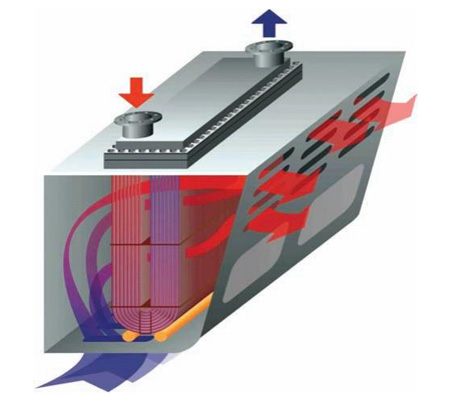
Fig. 1. Schematic of heat exchange process of box cooler
Box cooler tube bundle unit all submerged in seawater work, although the tube bundle material has a strong resistance to seawater corrosion, but the cooler tube bundle external if not protected with a coating, the use of 6 months after the corrosion and rust, but also prone to biological fouling, such as shellfish, snails, seaweed and other sea creatures. When the box cooler on the beginning of attached organisms, it is difficult to observe the impact of the cooler on the thermal performance, only when the surface of the cooler is comprehensively contaminated by organisms, tube bundles between the tube and the tube flow channel blockage can be intuitively judged.
Currently relatively simple external corrosion protection measures for the body is the cooler tube bundles and all contact with seawater are used in seawater corrosion-resistant materials, and the surface of the surface spraying phenolphthalein or phenolic resin paint coating in order to avoid the cooler and the hull of the electric current between the resulting galvanic corrosion, the coating also protects the cooler from corrosion of the deposits.
The SAEKAPHEN (Re) coating of the box cooler allows the box cooler to have a longer service life and prevents galvanic corrosion.

Box coolers made of copper-nickel-aluminum (Cu-Ni-Al) mounted in carbon steel (CS) sea cabinets, SAEKAPHEN's two-component, epoxy-hybrid oil repellent systems offer excellent seawater resistance and hydrophobic surfaces to resist the adhesion of marine organisms, including barnacles, as well as reliable operation and protection against galvanic coupling corrosion. This is achieved through carefully formulated filler compositions where heat transfer exceeds that of most heat-cured liners and has been proven through independent third-party testing. As the industry moves towards more environmentally friendly transportation, the coating does not contain any biocidal fillers.
Depending on the conditions of use, box coolers have longer or shorter maintenance schedules. This maintenance can range from simple cleaning to a complete re-coating process.SAEKAPHEN and its partner SIMIJIA offer on-site cleaning, blast cleaning and re-coating services at the shipyard or at a suitable available facility for all designs of box coolers, including round, rectangular or stepped. The use of Marine Growth Prevention Systems (MGPS), such as the Imposed Current Antifouling (ICAF) system, does not adversely affect the coating.
SAEKAPHEN and its partner SIMIJIA offer joint services for Box Coolers for all vessels, including yachts, ferries, trawlers, tugs, barges, carriers, dredgers, supply vessels, icebreakers, cargo ships, tankers, gas tankers and offshore structures.
In addition to these benefits, Box Coolers' recoating extends life cycles and has a proven track record. Since their introduction to the market, hundreds of Box Coolers have had the added advantage of being coated with SAEKAPHEN, resulting in significant time and cost savings as all services are provided locally. If required, SAEKAPHEN can provide skilled construction or instruction services while the vessel is in dry dock.
